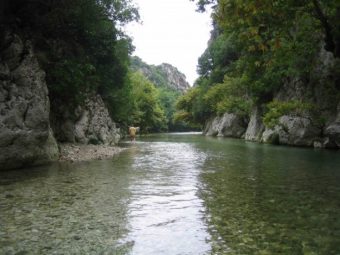Acheron river
 Acheron river near the village of Glyki.(foto)
Acheron river near the village of Glyki.(foto)
The Acheron is a river located in the Epirus region of northwest Greece. In ancient times the word Acheron was interpreted as ὁ ἄχεα ῥέων (ho akhea rheōn), meaning “the stream of woe”, and it was believed to be a branch of the underworld river Styx over which in ancient Greek mythology Charon ferried the newly dead souls across into Hades. The lake called Acherousia and the river still called Acheron with the nearby ruins of the Necromanteion are found near Parga on the mainland opposite Corfu.
Another branch of Acheron was believed to surface at the Acherusian cape (now Eregli in Turkey) and was seen by the Argonauts according to Apollonius of Rhodes. Greeks who settled in Italy identified the Acherusian lake into which Acheron flowed with Lake Avernus. Plato in his Phaedo identified Acheron as the second greatest river in the world, excelled only by Oceanus. He claimed that Acheron flowed in the opposite direction from Oceanus beneath the earth under desert places. The god of the river, son of Oceanus and Tethys fathered Ascalaphus with Orphne or Gorgyra.
The word is also occasionally used as a synecdoche for Hades itself. Virgil mentions Acheron with the other infernal rivers in his description of the underworld in Book VI of the Aeneid. In VII, line 312 he gives to Aeneas the famous saying, flectere si nequeo superos, Acheronta movebo: ‘If I cannot deflect the will of Heaven, I shall move Hell.’ The Acheron was sometimes referred to as a lake or swamp in Greek literature, as in Aristophanes’ The Frogs and Euripides’ Alcestis. In Dante’s Inferno, the Acheron river forms the border of Hell. Following Greek mythology, Charon ferries souls across this river to Hell.

